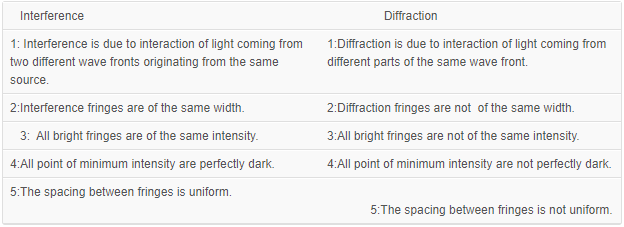Diffraction
The phenomenon of spreading of light when it is passed through small openings or obstacles is known as diffraction of light.
For diffraction to occur the size of the obstacle or aperture must be comparable to the wavelength of the incident waves.

Types of diffraction
i. Fresnel diffraction: In this diffraction either the source or the screen is near the aperture or the obstacle, the wavefronts are spherical and the pattern is quite complex.
ii. Fraunhofer diffraction: In this diffraction both the source and the screen are placed at a greater distance from the obstacle or aperture, the incident wavefront is plane waves and the rays leaving the opening are parallel.

The optical device which contains a large number of narrow equidistant and parallel slits to obtain the diffraction patterns is called diffraction grating.
The distance of one clear space and an opaque space is called grating element or grating spacing.
The resolving power of an optical instruments is an ability of an instrument to produce distinctly separate images of two close objects.
- In diffraction, the bright fringes are of varying brightness.
- Oil immersion objective microscopes are used to obtain high resolving power.
- Diffraction is shown by wave nature of light only.
- Diffraction is shown by both longitudinal and transverse wave.
Key Formula
- Condition for secondary minima: =, where n=
- Condition for secondary maxima: = , where n=
- Width of secondary maxima or minima:
- Width of central maxima:
- For nth principal maxima in diffraction grating:
- ; (a+b) is called grating element and N is the number of lines per unit length.
- Resolving power of microscope:
- Resolving power of telescope: ; D is the diameter of the objective lens.